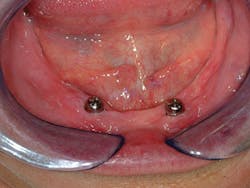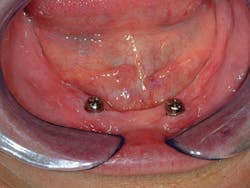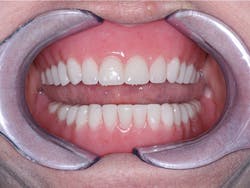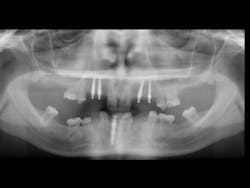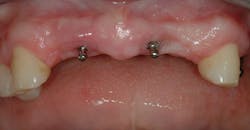Clinical situations most indicated for implants
Q: Although I suggest implants quite often to patients, I do not know the clinical indications for which implants have the most need. It seems that many clinical situations can be well treated with conventional dentistry, but some indications seem better suited for implants. What are the clinical situations for which implants are most needed and most easily accepted by patients?
A: Thanks for your question. I'm sure many dentists have the same frustration attempting to treatment plan for implant dentistry. In my answer, I will identify the categories of patient needs that are most appropriate for implants, and my observations on why more dentists are not treatment planning and accomplishing implant treatment. Consider this information seriously, and it will undoubtedly motivate you to incorporate more implant use into your practice.
Experienced dentists can easily prioritize the need for root-form dental implants. What areas of restorative dentistry or prosthodontics are most disagreeable to patients and cause the most dentist-patient distress? I'll provide my own experiences, and I'm confident you'll agree with most of them.
Complete dentures - What percentage of mandibular denture wearers are satisfied with their dentures? This is clearly the most disagreeable treatment provided by dentists. Mandibular complete dentures are, at best, only tolerated by most who wear them because many people do not know that additional retention and support can be obtained. However, maxillary complete dentures are often preferred over previously present, painful, carious and/or periodontally involved natural teeth. The reason for this is evident. Maxillary dentures have the palate on which to rest, while mandibular dentures are constantly moving because of tongue activity and lack of adequate bony support and soft tissue stability.
Estimates show that there are about 35 million edentulous persons in the U.S.1 Most of these edentulous people are unfamiliar with implants and their benefits and availability. That's our fault! Dentists and our staff are not adequately educating patients. If we educate patients thoroughly about the availability of implants and their value in providing support and retention for dentures, patients will want implants.
Another big reason most edentulous patients have not had implants is the constant promotion by newspapers, magazines, and TV of complex, extensive, and expensive techniques provided by some dentists and implant manufacturers. Yes, I agree that these complex plans are acceptable for some patients, but I'm convinced they're well beyond the budgets of most Americans. Thousands of edentulous patients have not been introduced to less expensive and less invasive implant treatment procedures. The majority of dentists are not using implants for edentulous patients. This treatment need is enormous, and it's only waiting for dentists to educate patients and make dentures more successful (Figures 1-3).
Figure 1 - Initial healing on two conventional diameter root form implants planned to help support and retain a mandibular complete denture.
Removable partial dentures
During your years of practice, what percentage of removable partial denture wearers, maxillary or mandibular, have praised you for the service of their prostheses? Patients routinely complain about loose or broken clasps, denture sore spots under resin or metal portions of the partial denture that are often Class 1 levers, or the unesthetic appearance of unsightly clasps. However, most patients accept removable partial dentures better than complete mandibular dentures. Can the acceptability of these prostheses be improved?
Yes! As you may have observed, every tooth remaining in a partially edentulous mouth has a good sized triangular piece of remaining bone, both mesial and distal. This bone is usually very dense because the facial and lingual cortical bone has collapsed toward the center of the ridge, leaving slight or no trabecular bone. This is an ideal, dense triangle of bone into which a single implant can be placed. Implants in such locations can have abutments placed on them, such as locators, ERAs, spheres, and other types of retainers. These abutments provide retention and stability for the removable partial denture, elimination of objectionable clasps, easy repair, and increase in retention when the partial denture becomes loose during service.
Placement of implants to assist in retention and support of removable partial dentures adds some cost to the prosthesis, but most patients can be educated so they will accept the implants and additional expense. I have yet to find a patient who does not feel that the extra cost is justified (Figure 4).
Kennedy class IV removable partial dentures
You will remember that patients with this classification of removable partial denture do not have any anterior teeth remaining. When a partial denture is placed in these situations, the denture almost always rocks under occlusal forces toward the anterior portion of the mouth, despite the dentist's best efforts. Regardless of whether the partial denture is maxillary or mandibular, the result is nearly always the same - a dissatisfied patient. Satisfying this patient is usually relatively easy, assuming there is adequate bone to allow conventional diameter (3 mm or larger) implants to be placed in the edentulous canine areas. If only a moderate amount of bone is present, small-diameter implants can be placed (1.8 mm to 2.9 mm). Adequate education usually influences a patient's desire to accept the treatment (Figure 5).
Kennedy classes I, II, and III
By definition, respectively these patients have no posterior teeth bilaterally, no posterior teeth unilaterally, or a few missing teeth with remaining teeth on both sides of the space(s). These patients can usually be treated well with conventional prosthodontic procedures, primarily fixed prostheses. Sometimes conventional treatment is better than implant-supported restorations. There are some advantages to not placing implants in these patients, especially if the remaining teeth already need crowns. The cost of one implant, an abutment, and a crown is about the same as a three-unit fixed prosthesis. The prosthesis can be delivered in a few days to a few weeks, and there is no need for soft tissue or bone trauma, or bone grafting. Many people do not want surgery, but they'll accept a fixed prosthesis.
Implants are not always the correct or most appropriate option. For Kennedy class I, II, and III situations, this is often the case.
Potential reasons for lack of implant placement
During my speaking engagements around the world, I often see disparate percentages of dentists who place implants as a routine procedure. Many groups of mainly general dentists have 25% or more of the dentists placing implants, while other groups have only a few dentists in an entire audience of several hundred who place implants. There are estimates concerning the percentage of dentists placing and restoring implants, but they vary enormously. Although many general dentists claim they are restoring implants, major dental laboratories report that implant-supported crowns, or implant-supported removable or fixed prosthesis units, are still a very small percentage of their production.2
Dentists need to educate patients more thoroughly
What are the most logical reasons for this obvious minimal use of implants, and what can be done to stimulate more implant use? Here are some potential reasons. See if any of them relate to you.
• Overt lack of dentist education regarding implant surgery or implant prosthodontics - Since this area is clearly the most important advancement in dentistry in the entire career of most dentists, dental schools should make implant education a mandatory part of predoctoral dental education.
• Fear they do not have enough education on the procedures - There are innumerable continuing education courses on implant dentistry that can prepare dentists to become competent with at least the basic aspects of implant dentistry.
• Lack of knowledge about the cost of implant surgery and prosthodontic kits - Early in the development of implant dentistry, surgical kits were very expensive. That is no longer the situation. Dentists can obtain both implant dentistry education and the necessary armamentaria for implant dentistry for several thousand dollars.
• A dislike of the surgical aspects of dentistry - I can't overcome this point for you. Since most dentists are doing at least some implant prosthodontics, they should try implant surgery. Most dentists will revive their excitement about the profession.
• Lack of patient interest in implants - Sorry, this is your fault. Patients who are adequately educated want implants. Educate your hygienists, assistants, and business staff to tell patients about implants using models, pamphlets, videos, and books, and they will want and often demand the treatment.
• Satisfaction with what you're already doing in your practice - The desire to change or not is a personal characteristic. As one of the oldest practitioners in dentistry, I can testify that what has kept me mentally and physically active in the profession for several decades is getting into at least one new concept or technique every year of my professional life. Do it!
Summary
I've shared my thoughts about the most important indications for use of implants. Complete dentures and removable partial dentures should have implant support and retention on a routine basis. Patient satisfaction with these prostheses is markedly improved by placement of implants. Additionally, numerous other clinical situations require patient education to help patients compare implant-supported restorations vs. conventional restorations. For satisfactory patient acceptance, implants are mandatory for several of the situations described in this column. The time has come for all dentists to become knowledgeable about both implant prosthodontics and implant surgery, and to incorporate more implant use into their practices.
REFERENCES
1. American College of Prosthodontists. Facts & Figures. http://www.gotoapro.org/news/facts--figures/. Accessed 7/22/2014.
2. Personal communication, Dr. Michael DiTolla, Director, Clinical Education & Research, Glidewell Laboratories, November 4, 2014.
Gordon J. Christensen, DDS, MSD, PhD, is a practicing prosthodontist in Provo, Utah. He is the founder and director of Practical Clinical Courses, an international continuing-education organization initiated in 1981 for dental professionals. Dr. Christensen is a cofounder (with his wife, Dr. Rella Christensen) and CEO of Clinicians Report (formerly Clinical Research Associates).
